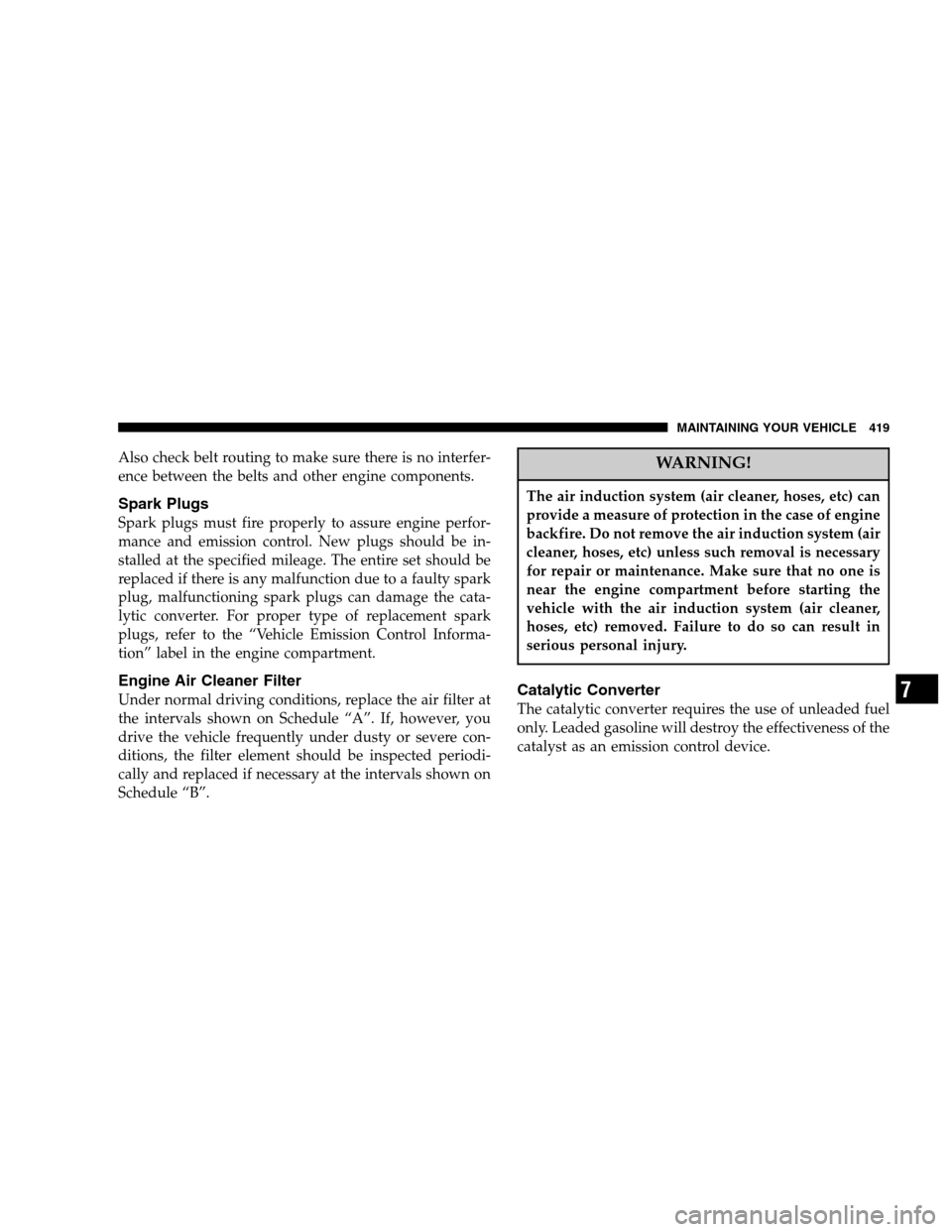2007 CHRYSLER TOWN AND COUNTRY gas type
[x] Cancel search: gas typePage 401 of 504

•For convenience in checking the spare tire inflation,
stow with the valve stem toward the rear of the
vehicle.
•Using the jack handle, rotate the drive nut to the
right until the wheel is drawn into place against the
underside of the vehicle.
•Continue to rotate the nut until you hear the mecha-
nism click three times. It cannot be overtightened.
Push against the tire several times to be sure it is
securely in place.
13. Stow the jack and jack handle.
14. Check the tire pressure as soon as possible. Correct
pressure as required.
JUMP-STARTING PROCEDURE
WARNING!
•Do not attempt to push or tow your vehicle to get it started. Vehicles
equipped with an automatic transmission cannot be started this
way. Unburned fuel could enter the catalytic converter and once the
engine has started, ignite and damage the converter and vehicle. If
the vehicle has a discharged battery, booster cables may be used to
obtain a start from another vehicle. This type of start can be
dangerous if done improperly, so follow this procedure carefully.
•Battery fluid is a corrosive acid solution; do not allow battery fluid
to contact eyes, skin or clothing. Don’t lean over battery when
attaching clamps or allow the clamps to touch each other. If acid
splashes in eyes or on skin, flush contaminated area immediately
with large quantities of water.
•A battery generates hydrogen gas which is flammable and explo-
sive. Keep flame or spark away from the vent holes. Do not use a
booster battery or any other booster source with an output that
exceeds 12 volts.
•Take care to avoid the radiator cooling fan whenever the hood is
raised. It can start anytime the ignition switch is on. You can be hurt
by the fan.
WHAT TO DO IN EMERGENCIES 401
6
Page 419 of 504

Also check belt routing to make sure there is no interfer-
ence between the belts and other engine components.
Spark Plugs
Spark plugs must fire properly to assure engine perfor-
mance and emission control. New plugs should be in-
stalled at the specified mileage. The entire set should be
replaced if there is any malfunction due to a faulty spark
plug, malfunctioning spark plugs can damage the cata-
lytic converter. For proper type of replacement spark
plugs, refer to the “Vehicle Emission Control Informa-
tion” label in the engine compartment.
Engine Air Cleaner Filter
Under normal driving conditions, replace the air filter at
the intervals shown on Schedule “A”. If, however, you
drive the vehicle frequently under dusty or severe con-
ditions, the filter element should be inspected periodi-
cally and replaced if necessary at the intervals shown on
Schedule “B”.
WARNING!
The air induction system (air cleaner, hoses, etc) can
provide a measure of protection in the case of engine
backfire. Do not remove the air induction system (air
cleaner, hoses, etc) unless such removal is necessary
for repair or maintenance. Make sure that no one is
near the engine compartment before starting the
vehicle with the air induction system (air cleaner,
hoses, etc) removed. Failure to do so can result in
serious personal injury.
Catalytic Converter
The catalytic converter requires the use of unleaded fuel
only. Leaded gasoline will destroy the effectiveness of the
catalyst as an emission control device.
MAINTAINING YOUR VEHICLE 419
7
Page 434 of 504

•Check coolant freeze point in the radiator and in the
coolant recovery bottle. If antifreeze needs to be
added, contents of coolant recovery bottle must also be
protected against freezing.
•If frequent coolant additions are required, or if the
level in the coolant recovery bottle does not drop when
the engine cools, the cooling system should be pres-
sure tested for leaks.
•Maintain coolant concentration at 50% HOAT engine
coolant (minimum) and distilled water for proper
corrosion protection of your engine which contains
aluminum components.
•Make sure that the radiator and coolant recovery
bottle overflow hoses are not kinked or obstructed.
•Keep the front of the radiator clean. If your vehicle is
equipped with air conditioning, keep the front of the
condenser clean, also.
•Do not change the thermostat for summer or winter
operation. If replacement is ever necessary, install
ONLY the correct type thermostat. Other designs may
result in unsatisfactory coolant performance, poor gas
mileage, and increased emissions.
Hoses And Vacuum/Vapor Harnesses
Inspect surfaces of hoses and nylon tubing for evidence
of heat and mechanical damage. Hard or soft spots,
brittle rubber, cracking, tears, cuts, abrasions, and exces-
sive swelling indicate deterioration of the rubber.
Pay particular attention to those hoses nearest to high
heat sources such as the exhaust manifold. Inspect hose
routing to be sure hoses do not come in contact with any
heat source or moving component which may cause heat
damage or mechanical wear.
Insure nylon tubing in these areas has not melted or
collapsed.
434 MAINTAINING YOUR VEHICLE
Page 438 of 504

CAUTION!
Do not allow petroleum base fluid to contaminate
the brake fluid — all brake seal components could
be damaged causing partial or complete brake fail-
ure.
Fuel System Hoses
Electronic Fuel Injection high pressure fuel systems are
designed with hoses which have unique material charac-
teristics to provide adequate sealing and resist attack by
deteriorated gasoline.
Use only the manufacturers specified hoses in any fuel
system servicing. It is mandatory to replace all clamps
that have been loosened or removed during service. Care
should be taken in installing new clamps to insure they
are properly torqued.
Automatic Transmission
The automatic transmission and differential assembly are
contained within a single housing.
All automatic transmissions are equipped with a conven-
tional filler tube and dipstick. If fluid is added, it should
be added through the dipstick hole in the case.
The dipstick is located just behind the radiator, lower
right side.
Selection of Lubricant
It is important that the proper lubricant is used in the
transmission to assure optimum transmission perfor-
mance. Use only manufacturers recommended transmis-
sion fluid, refer to Fluids, Lubricants and Genuine Parts
for correct fluid type. It is important that the transmission
fluid be maintained at the prescribed level using the
recommended fluid.
438 MAINTAINING YOUR VEHICLE
Page 487 of 504

Reset Mode.......................... 313
Selection Of Lubricant................438,458
Shifting ............................. 313
Special Additives...................... 441
Automatic Transmission................... 438
Adding Fluid......................... 439
Fluid and Filter Changes................. 440
Fluid Change......................... 440
Fluid Level Check...................... 439
FluidType ........................438,458
BallJoints ............................. 425
Battery............................... 421
Gas Caution.......................... 422
Jump Starting......................... 401
Keyless Transmitter Replacement (RKE)....... 25
Saving Feature (Protection)............... 153
Bearings.............................. 441
Belts,Drive ............................ 418Body Mechanism Lubrication............... 426
B-Pillar Location........................ 328
Brake Fluid............................ 458
Brake, Parking.......................... 315
Brake System........................317,435
Anti-Lock (ABS)....................... 317
Fluid Check.......................... 437
Hoses.............................. 436
Warning Light........................ 212
Brakes.............................317,435
Brake/Transmission Interlock............... 312
Break-In Recommendations, New Vehicle........ 86
Bulb Replacement....................... 452
Bulbs,Light ............................ 451
Calibration, Compass..................... 168
Capacities, Fluid........................ 457
Caps, Filler
Fuel................................ 353
INDEX 487
10